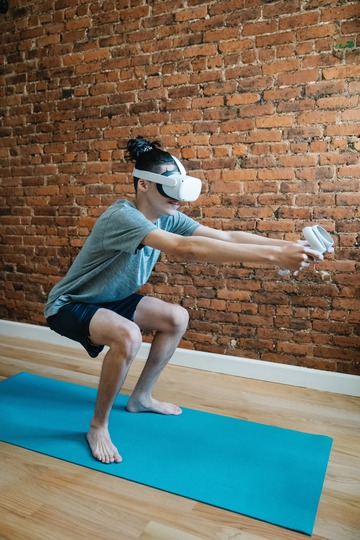The Future of Home Fitness: Cutting-Edge Technologies for Personal Wellness and Exercise

The fitness industry has undergone a significant transformation in recent years, with the rise of technology playing a pivotal role in the way people approach wellness, health and exercise. With the global pandemic making it difficult to visit gyms and fitness centers, home fitness has become the new norm, and technology has stepped up to make it more convenient and effective than ever before.
From smart workout equipment to virtual personal trainers, the future of home fitness is incredibly exciting. In this article, we will explore some of the cutting-edge technologies that are driving this revolution and what we can expect from the world of home fitness in the coming years.
Smart Workout Equipment
Gone are the days of bulky, unattractive workout equipment that takes up too much space in your home. Smart workout equipment has taken over, offering a sleek and connected solution that allows you to get a full-body workout without leaving your living room.
One example of this is the Peloton bike, which has become a household name in recent years. The Peloton bike offers live and on-demand classes, led by world-class instructors, that you can take from the comfort of your own home. The bike is equipped with a high-definition screen that displays the class, while sensors track your progress and provide real-time feedback on your performance.
But Peloton is just one example of smart workout equipment. Companies like Tonal and Mirror offer all-in-one home gyms that use digital weights and resistance to provide a personalized workout experience. With these devices, you can perform a variety of exercises and track your progress over time, all without having to leave your house.
Virtual Personal Trainers
Personal trainers are a great way to stay motivated and ensure that you are working out safely and effectively. However, they can be expensive and may not be available in your area. That’s where virtual personal trainers come in.
Virtual personal trainers are AI-powered apps that provide customized workout plans based on your fitness level, goals, and preferences. They use machine learning algorithms to analyze your data and provide real-time feedback on your progress. Some examples of these apps include Fitbod, which creates personalized workout plans based on your fitness goals and available equipment, and Aaptiv, which offers audio-guided workouts led by certified personal trainers.
Another example is AI-powered smart home gyms like Tempo, which provides personalized feedback and workout recommendations from certified trainers using computer vision technology. These virtual personal trainers make it easy to stay on track and achieve your fitness goals without having to leave your house.
Wearable Fitness Technology
Wearable fitness technology has been around for a while, but it continues to evolve and improve. Wearable fitness devices, like Fitbit and Apple Watch, track your heart rate, steps, and calories burned, allowing you to monitor your progress and adjust your workouts accordingly.
But wearable fitness technology is becoming more advanced. For example, companies like Whoop are creating wearable devices that track not only your physical activity but also your sleep and recovery. This data is used to provide personalized recommendations on how to optimize your workouts and recovery to achieve your fitness goals.
Another example is the Nadi X smart yoga pants, which use embedded sensors to provide real-time feedback on your yoga practice. The pants can detect when you are in a certain position and provide feedback through vibrations, helping you to achieve the correct posture and alignment.
Virtual Reality Fitness
Virtual reality (VR) technology is taking the fitness world by storm, offering an immersive and engaging workout experience that makes you feel like you are actually in the gym or studio. With VR fitness, you can work out in a variety of virtual environments, from a beach to a mountain top, all while tracking your progress and receiving feedback on your performance.
One example of this is the VR fitness app Supernatural, which provides a full-body workout using virtual reality technology. The app features world-class instructors and a variety of virtual environments, and the workouts are designed to provide a fun and engaging experience while still challenging your body.
Another example is the VR fitness game Beat Saber, which combines music and exercise in a unique and entertaining way. In the game, you use virtual lightsabers to slice through blocks to the beat of the music. The game provides a high-energy workout that is both fun and challenging.
The Future of Home Fitness
The future of home fitness is incredibly exciting, and we can expect to see even more innovative technologies emerge in the coming years. One trend that is likely to continue is the integration of AI and machine learning into fitness technology. As more data is collected on our workouts and fitness habits, AI will be able to provide even more personalized and effective workout recommendations.
Another trend is the continued growth of VR fitness. As the technology improves and becomes more accessible, we can expect to see a wider variety of VR fitness options available, from high-intensity cardio to gentle yoga.
We can also expect to see more integration between different types of fitness technology. For example, a smart home gym could be connected to a virtual personal trainer and wearable fitness device, providing a complete and integrated workout experience.
Overall, the future of home fitness is bright, and the technology that is driving this revolution is making it easier and more convenient than ever before to achieve your fitness goals. Whether you prefer to work out alone or with a virtual community, there is a fitness technology solution out there for you. So, if you haven’t already, it’s time to embrace the future of home fitness and take your wellness and exercise to the next level.
However, it’s important to note that while these technologies offer many benefits, they should not be seen as a replacement for traditional forms of exercise or a healthy lifestyle. It’s still important to eat a balanced diet, get enough sleep, and engage in physical activity regularly.
Additionally, while the convenience of home fitness is great, it’s important to find ways to stay motivated and accountable. Virtual personal trainers and community-based fitness platforms can help with this, but it’s also important to find a workout routine that you enjoy and that fits your lifestyle.
Furthermore, it’s important to consider the cost of these technologies. While some options, such as fitness apps, are relatively inexpensive, others, like smart home gyms, can be quite expensive. It’s important to consider your budget and do your research before investing in any fitness technology.
Finally, it’s worth noting that not everyone will have access to these technologies. Inequality in access to technology is a significant issue, and it’s important to find ways to make these technologies more accessible and inclusive.
As the fitness industry continues to evolve, it’s important to stay informed and up-to-date on the latest technologies and trends. This can help you make informed decisions about what technologies to invest in and what workout routines to pursue.
In addition to staying informed, it’s important to stay engaged and motivated. Setting achievable goals and tracking your progress can help you stay on track and motivated. Joining a virtual fitness community or finding a virtual personal trainer can also help provide accountability and support.
It’s also important to listen to your body and take rest days when needed. Overtraining can lead to injury and burnout, so it’s important to find a balance between pushing yourself and giving your body the rest and recovery it needs.
Ultimately, the future of home fitness is about finding what works for you and your lifestyle. With the right technology, mindset, and approach, you can achieve your fitness goals and improve your overall wellness from the comfort of your own home.
Conclusion
In conclusion, the future of home fitness is a promising one, offering a wide range of cutting-edge technologies that can help people achieve their fitness goals and improve their overall wellness. From AI-powered personal trainers to virtual reality workouts, there are numerous options available for people to exercise in the comfort of their own homes.
While these technologies are convenient and can be effective, it’s important to approach them with a critical eye and not view them as a replacement for traditional forms of exercise or a healthy lifestyle. Additionally, it’s important to find ways to stay motivated and engaged, whether that’s through joining a virtual fitness community, setting achievable goals, or finding a workout routine that you enjoy.
Finally, it’s important to acknowledge the issues of accessibility and inequality in access to fitness technology. Efforts should be made to make these technologies more affordable and inclusive so that everyone has the opportunity to benefit from them.
Overall, the future of home fitness is a bright one, and with the right technology, mindset, and approach, anyone can achieve their fitness goals and improve their overall wellness from the comfort of their own home.



